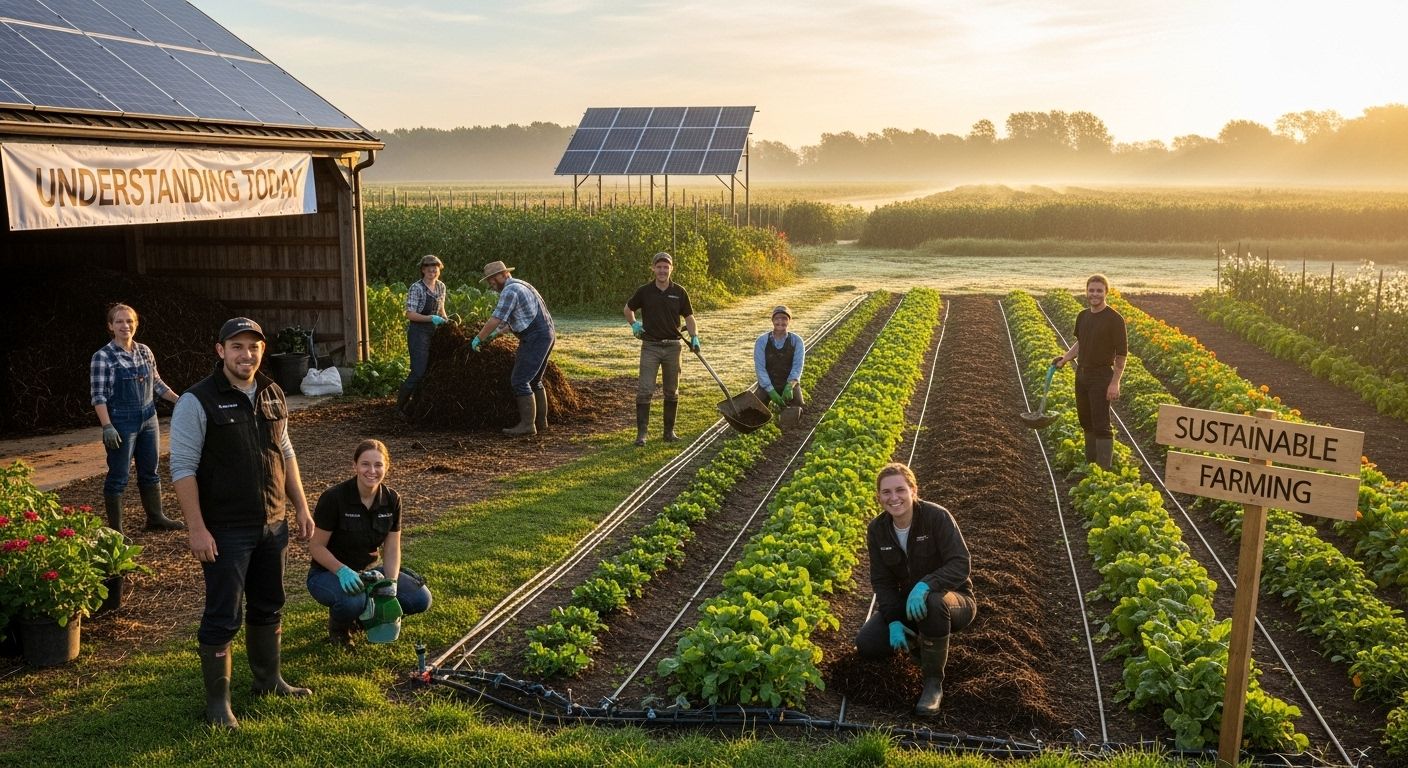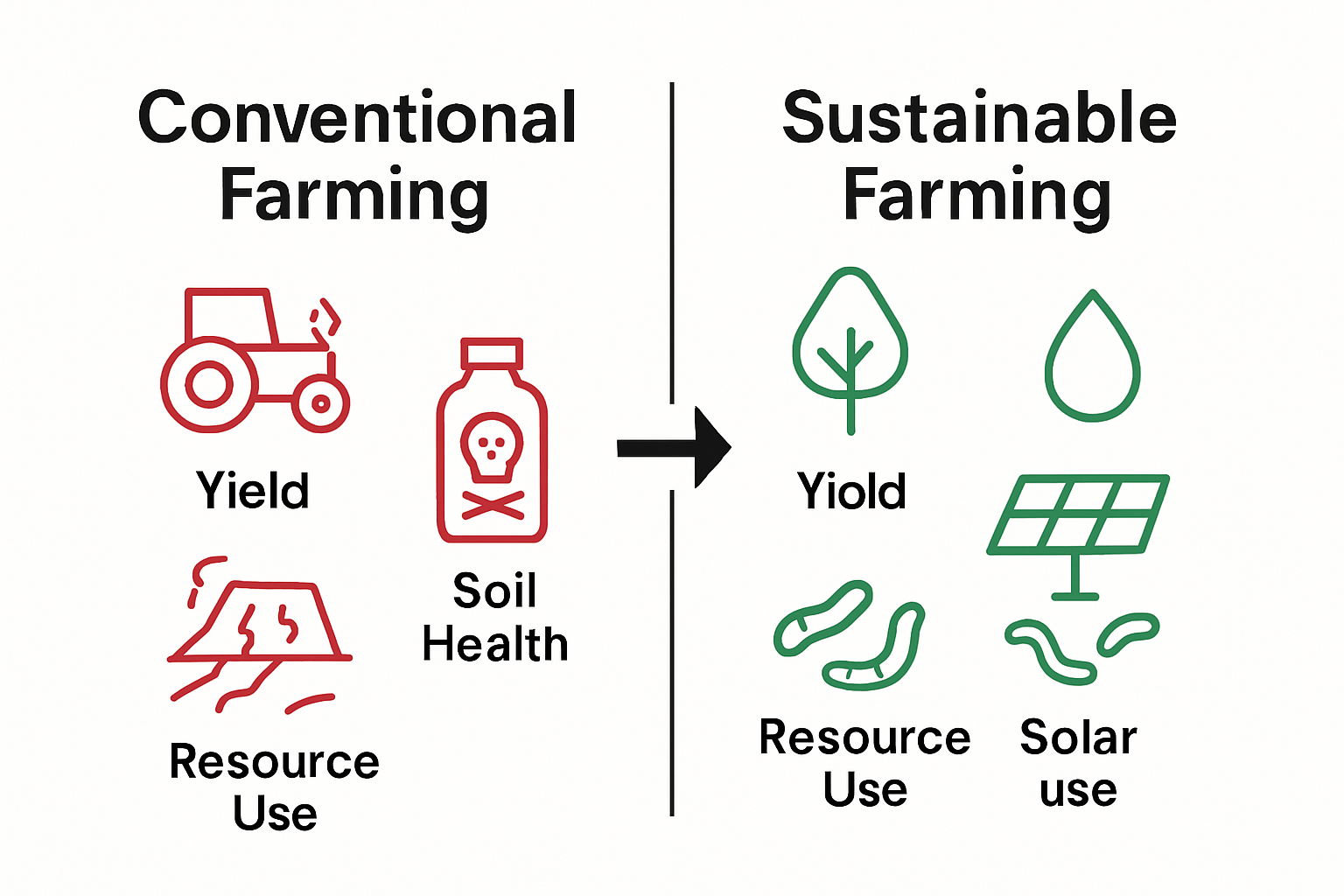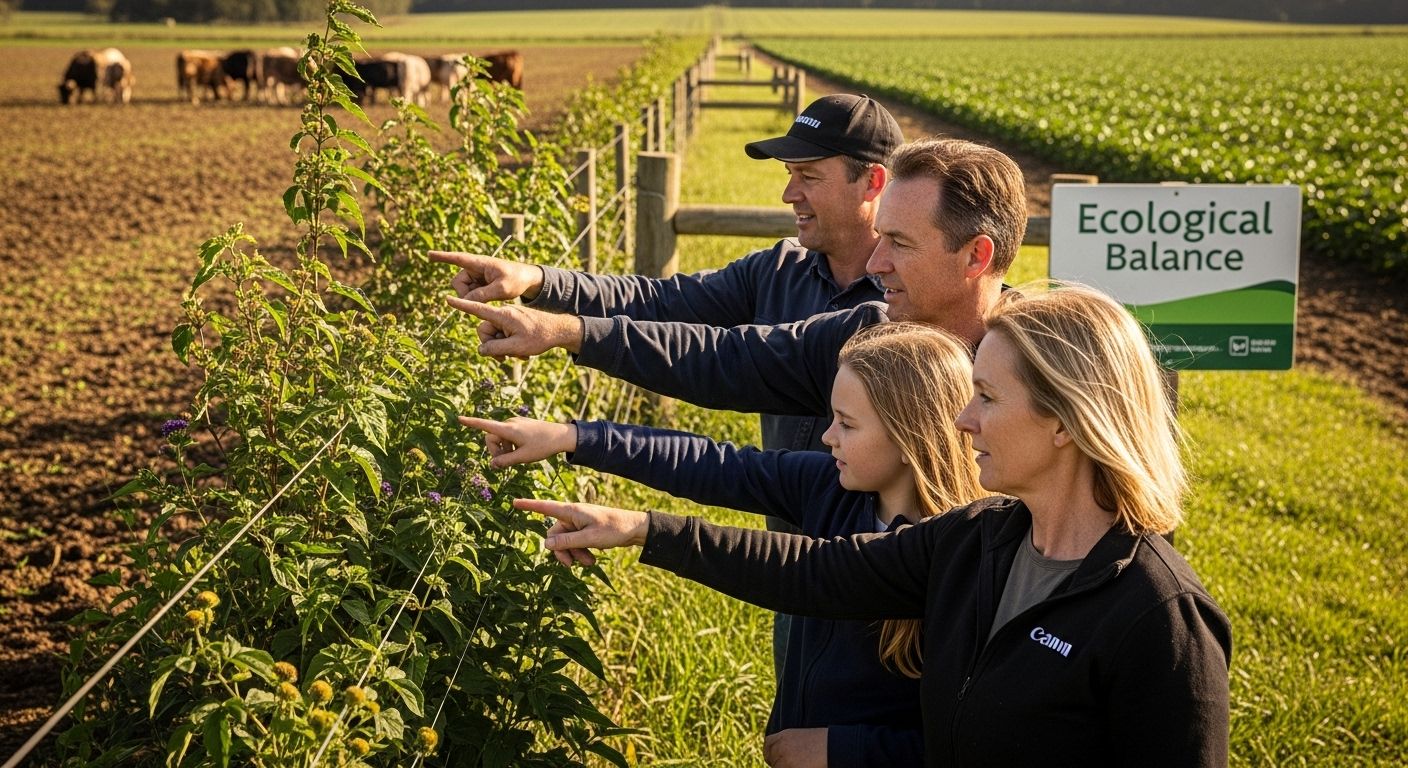
Sustainable farming is changing the way food gets produced worldwide. Over 30 percent of global farmland is now managed with eco-friendly practices, according to the Food and Agriculture Organization. Most people still imagine farming as all about short-term yield and heavy chemical use. That thinking leaves out the real story. The biggest impact of sustainable farming is not just better crops but restoring the land itself for future generations.
Table of Contents
- What Are Sustainable Farming Practices?
- Why Sustainable Farming Practices Matter
- How Sustainable Farming Practices Benefit The Environment
- Key Principles Of Sustainable Farming Practices
- Real-World Examples Of Sustainable Farming Practices
Quick Summary
| Takeaway | Explanation |
|---|---|
| Sustainable farming maintains ecological balance | This practice integrates agriculture with natural ecosystems, ensuring future food production while preserving environmental health. |
| Focus on soil health enhances productivity | Techniques like crop rotation and minimal tillage improve soil fertility and structure, leading to better yield over time. |
| Reduce chemical use for long-term benefits | Utilizing natural pest management and organic alternatives minimizes ecological damage and promotes biodiversity on farms. |
| Economic resilience supports rural communities | Sustainable approaches create stable agricultural systems, increasing farm profitability and enhancing local economies while reducing reliance on external inputs. |
| Adopt regenerative practices for ecosystem restoration | Farmers can implement strategies like cover cropping and agroforestry to actively rebuild soil health and biodiversity, transforming agriculture into a regenerative force. |
What are Sustainable Farming Practices?
Sustainable farming practices represent a holistic approach to agricultural production that balances environmental health, economic profitability, and social equity. These practices go beyond traditional agricultural methods by focusing on long term ecosystem preservation and resource conservation.
Defining Sustainable Agriculture
At its core, sustainable farming aims to meet current food production needs without compromising the ability of future generations to produce food. This approach recognizes that agricultural systems are interconnected with natural ecosystems and human communities. Unlike conventional farming, which often prioritizes short term yields, sustainable practices seek to create resilient agricultural systems that work in harmony with natural processes.
Key characteristics of sustainable farming include:
The table below organizes the key characteristics of sustainable farming, helping clarify how these features set it apart from conventional agriculture.
| Characteristic | Description |
|---|---|
| Minimizing Environmental Impact | Reduces pollution, resource depletion, and habitat destruction |
| Preserving Soil Health and Biodiversity | Maintains soil fertility and supports diverse ecosystems |
| Reducing Chemical Inputs and Fertilizers | Limits synthetic substances for ecological safety |
| Protecting Water Resources | Ensures efficient, clean water use in agriculture |
| Supporting Local Agricultural Economies | Boosts rural economies and community stability |
- Minimizing environmental impact
- Preserving soil health and biodiversity
- Reducing chemical inputs and synthetic fertilizers
- Protecting water resources
- Supporting local agricultural economies
Principles of Sustainable Farming Practices
Sustainable farming integrates several critical principles designed to promote ecological balance. According to National Sustainable Agriculture Coalition, these practices encompass methods that protect natural resources while maintaining agricultural productivity. Farmers implementing sustainable approaches typically focus on:
- Crop rotation to maintain soil nutrients
- Natural pest management techniques
- Water conservation strategies
- Promoting biodiversity through mixed cropping systems
- Using renewable energy sources in agricultural operations
These practices represent a comprehensive strategy that recognizes agriculture as more than just food production. By treating farmland as a living ecosystem, sustainable farming creates a more resilient and regenerative approach to agriculture that supports both environmental health and human food security.
Why Sustainable Farming Practices Matter
Sustainable farming practices are not just an agricultural trend but a critical approach to addressing global challenges of food security, environmental preservation, and economic resilience. These practices have profound implications for our planet’s future and human survival.

Environmental Impact and Climate Resilience
Sustainable farming directly confronts climate change by reducing greenhouse gas emissions and creating more resilient agricultural systems. Research from the United Nations Environment Programme indicates that sustainable agriculture uses significantly less energy and produces fewer carbon emissions compared to traditional farming methods. By focusing on ecological balance, these practices help mitigate environmental degradation and support long term ecosystem health.
Key environmental benefits include:
- Reducing carbon footprint in agricultural production
- Protecting biodiversity and natural habitats
- Minimizing soil erosion and degradation
- Conserving water resources
- Decreasing chemical pollution
Economic and Social Sustainability
Beyond environmental considerations, sustainable farming practices offer substantial economic advantages. They create more stable agricultural systems that can withstand climate variations and market fluctuations. Our guide on land management strategies provides deeper insights into creating resilient agricultural operations.
Sustainable approaches support:
- Increased long term farm profitability
- Enhanced food security
- More stable rural economies
- Improved farmer and community well being
- Reduced dependency on external inputs
By integrating ecological principles with agricultural production, sustainable farming represents a holistic solution to some of the most pressing challenges facing global agriculture. It demonstrates that economic productivity and environmental stewardship can coexist harmoniously, creating a more sustainable future for generations to come.
How Sustainable Farming Practices Benefit the Environment
Sustainable farming practices represent a powerful approach to environmental conservation, offering comprehensive solutions to complex ecological challenges. By reimagining agricultural systems, these methods create significant positive impacts on natural ecosystems and global environmental health.
Soil Health and Carbon Sequestration
One of the most critical environmental benefits of sustainable farming is its profound impact on soil health. Unlike conventional agricultural methods that deplete soil nutrients, sustainable practices focus on rebuilding and preserving soil quality. Research from the Food and Agriculture Organization demonstrates that techniques like crop rotation, minimal tillage, and organic fertilization can dramatically improve soil structure and fertility.
Key soil health benefits include:
- Enhanced soil organic matter content
- Improved water retention capabilities
- Increased microbial diversity
- Reduced soil erosion
- Natural carbon sequestration
Biodiversity Protection and Ecosystem Restoration
Sustainable farming practices play a crucial role in protecting and restoring biodiversity. By minimizing chemical interventions and creating more complex agricultural landscapes, farmers can support diverse ecosystems. Our guide on land management strategies provides additional insights into ecological preservation techniques.
Benefits for biodiversity include:
- Creating habitats for beneficial insects
- Supporting wildlife corridors
- Preserving native plant species
- Reducing chemical contamination
- Promoting genetic diversity in agricultural systems
These practices transform agriculture from a potential environmental threat to a regenerative force. By working in harmony with natural systems, sustainable farming demonstrates that food production can simultaneously nourish human populations and support ecological resilience.
The following table compares several key sustainable farming practices and highlights their primary environmental benefits for easy reference.
| Practice | Main Focus | Environmental Benefit |
|---|---|---|
| Crop Rotation | Alternating crops seasonally | Improves soil fertility, reduces pests |
| Minimal Tillage | Reducing soil disturbance | Decreases erosion, boosts soil structure |
| Cover Cropping | Planting soil-protective crops | Limits erosion, increases organic matter |
| Natural Pest Management | Ecosystem-based pest control | Lowers chemical use, enhances biodiversity |
| Agroforestry | Integrating trees and crops | Restores habitat, supports soil and water |
| Holistic Grazing | Managed livestock movement | Promotes soil health, encourages regrowth |
Key Principles of Sustainable Farming Practices
Sustainable farming is not a singular approach but a comprehensive framework of interconnected principles designed to create resilient, environmentally responsible agricultural systems. These principles guide farmers in developing holistic strategies that balance productivity with ecological stewardship.
Ecological Systems Integration
The foundational principle of sustainable farming centers on understanding agriculture as an integrated ecological system. This approach recognizes that farms are not isolated production units but complex environments interconnected with surrounding ecosystems. Research from the Food and Agriculture Organization emphasizes the importance of viewing agricultural landscapes as living, dynamic networks.
Key ecological integration strategies include:
- Mimicking natural ecosystem processes
- Promoting biodiversity within agricultural landscapes
- Maintaining natural habitat connections
- Reducing external chemical interventions
- Creating resilient agricultural ecosystems
Resource Conservation and Regeneration
Sustainable farming prioritizes conservation and active regeneration of natural resources. This principle goes beyond mere preservation, focusing on actively improving environmental conditions. Our guide on sustainable water management provides deeper insights into resource conservation techniques.
Primary resource conservation principles include:
- Minimizing soil disturbance
- Implementing water-efficient irrigation methods
- Utilizing renewable energy sources
- Practicing comprehensive nutrient management
- Protecting and enhancing natural water cycles
By adhering to these principles, sustainable farming transforms agricultural production from an extractive practice to a regenerative process that supports long term ecological and economic resilience. The goal is not just maintaining current conditions but actively improving environmental and agricultural systems for future generations.
Real-World Examples of Sustainable Farming Practices
Sustainable farming practices are not theoretical concepts but dynamic, practical approaches being implemented by farmers worldwide. These real-world applications demonstrate how ecological principles can be translated into effective agricultural strategies that benefit both producers and the environment.
Regenerative Agriculture Techniques
Research from the Food and Agriculture Organization highlights innovative sustainable farming approaches implemented globally. Regenerative agriculture represents a transformative method that goes beyond traditional conservation, actively rebuilding and enhancing ecosystem health. Farmers practicing this approach focus on restoring soil biodiversity, increasing organic matter, and creating self sustaining agricultural systems.
Key regenerative agriculture practices include:
- Cover cropping to protect and enrich soil
- Holistic grazing management
- Minimal tillage techniques
- Integrated crop and livestock systems
- Diverse crop rotations
Agroforestry and Integrated Farming Systems
Agroforestry represents another powerful sustainable farming approach that combines trees, shrubs, and agricultural crops in interconnected systems. Our guide on building windbreaks provides additional context about integrating landscape elements into farming practices.
Sophisticated agroforestry strategies encompass:
- Silvopastoral systems combining trees and livestock
- Alley cropping with interspersed tree rows
- Riparian buffer zone management
- Multi species cropping techniques
- Urban and peri urban agricultural models
These real world examples demonstrate that sustainable farming is not a single method but a complex, adaptive approach tailored to specific ecological and agricultural contexts. By integrating innovative techniques, farmers can create resilient, productive agricultural systems that work in harmony with natural processes.

Take Sustainable Farming From Theory to Practice With the Right Tools
Are you ready to make your farm more resilient and eco-friendly but feel stuck by practical challenges? Transitioning to sustainable farming requires more than knowledge. You need reliable tools that support soil health, biodiversity, and efficient resource use, just like the article described. Without the right fencing or animal management systems, it can be tough to protect wildlife corridors, implement rotational grazing, or monitor livestock health. Many farmers struggle to put sustainable principles into action without easy access to specialized equipment or expert advice.

Let your commitment to the environment drive real results on your land today. Explore FenceFast.ca for proven solutions that make sustainable farming possible. Discover our wide selection of electric fencing supplies and livestock management products designed for Canadian conditions. Shop now for the tools that help you build stronger soil, conserve resources, and enhance your animals’ wellbeing. Visit our website and start making sustainability a reality.
Frequently Asked Questions
What are the key characteristics of sustainable farming?
Sustainable farming emphasizes minimizing environmental impact, preserving soil health, reducing chemical inputs, protecting water resources, and supporting local agricultural economies.
How do sustainable farming practices benefit the environment?
Sustainable farming helps reduce greenhouse gas emissions, protects biodiversity, minimizes soil erosion, conserves water resources, and decreases chemical pollution, contributing to overall environmental health.
What are some examples of sustainable farming techniques?
Examples include crop rotation, natural pest management, cover cropping, minimal tillage, and agroforestry systems that integrate trees with agricultural crops.
How does sustainable farming contribute to food security?
By creating resilient agricultural systems that can withstand climate variations and market fluctuations, sustainable farming enhances food security and long-term farm profitability.
